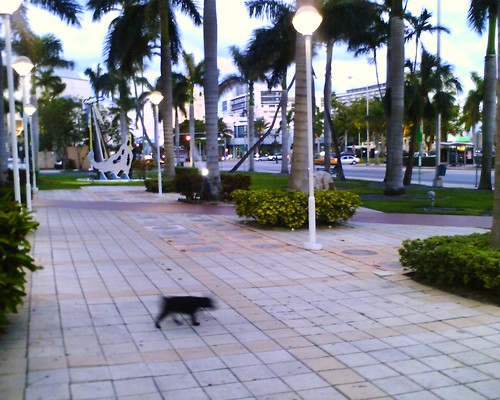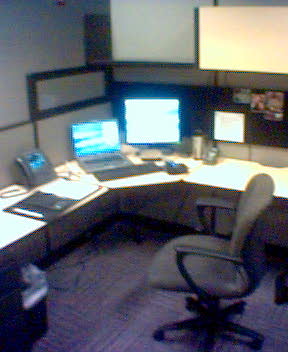 After working with my new Cingular 8125 for a few days, I can say it’s a keeper. As soon as my memory card gets here, I’ll probably even stop carrying my laptop home during the week. I haven’t even started putting 3rd party applications on it yet, but I can say that it’s going to be my primary electronic device outside of the office.
After working with my new Cingular 8125 for a few days, I can say it’s a keeper. As soon as my memory card gets here, I’ll probably even stop carrying my laptop home during the week. I haven’t even started putting 3rd party applications on it yet, but I can say that it’s going to be my primary electronic device outside of the office.
Every single good feature, though, has the oddest drawbacks that point to insufficient testing.
Good: the keyboard buttons are huge and make typing a breeze. Bad: there are so many buttons scattered all over the damn thing that it’s almost impossible to hold without accidentally triggering the camera, voice dialing, comm manager, etc. It’s great for short-term typing, say one paragraph or less, but anything longer than that is risking disaster. It’s just too easy to accidentally start another application right in the middle of typing a paragraph, and then depending on what keys you’re in the middle of pressing, you might trigger disaster. I’ve started phone calls to people, deleted files, taken pictures, etc, all while trying to just type a letter.
Furthermore, with so many multi-purpose buttons liberally slathered all over the phone, why take up onscreen space with visual buttons that have the same purpose? There’s a dedicated hardware button for the Comm Manager – why take up an entire line of the “Today” screen to show one tiny icon for it as well? And don’t get me started about the location of the Power button: when the phone is holstered, the power button is precisely positioned to hit the seat belt socket in a car. Every time I get into the car, I turn the phone on without knowing it, and then as I buckle the seat belt, it places a call. I’m to the point now where I just take the phone off before I get in the car.
Good: two soft keys make it easy to get around in most screens, and HTC even duplicated them above the keyboard for use when the unit is in landscape mode. Bad: these two buttons are so close to the keys that they’re almost impossible to avoid. When composing email, the soft key right above the E will instantly send the email without asking if you’re sure. I looked like an idiot when I sent out three partially completed emails in a row to a group of execs. Not good. If this setup was tested, it was tested by somebody with needles for fingers.
Good: the 8125 comes with a stereo earbud headset with microphone, and it makes a killer wireless walkman. I love walking the dog while listening to Jimmy Buffett’s Radio Margaritaville over the internet, all live. Bad: the earbuds are huge. We’re talking mammoth. I don’t have small ears by any means, but I can’t keep these earbuds in my ears. They pop out at the slightest provocation because they’re apparently designed to fit in Ernie’s ears. There’s no way anybody tested these before deploying them.
Good: the camera takes great pictures for a PDA/phone. The picture you see here was taken outside at dusk with minimal lighting. The camera is very light-sensitive for a simple PDA, and a $300 PDA at that. Bad: despite buttons scattered all over the surface of this device, it’s impossible to change most of the camera settings without getting out the stylus.
Good: underground firmware available on the web enables Microsoft Direct Push email with Exchange. Companies using Exchange Server 2003 with SP2 can enable push email out to PDA’s and phones without paying for GoodLink or Blackberry Enterprise Server setups. It works pretty well out of the box with no configuration. Bad: while the push email does work, it isn’t anywhere near the speed of GoodLink or Blackberry devices. I routinely got emails on my PDA several minutes after they arrived in my inbox – not acceptable for “instant” email. Thankfully, our company uses GoodLink as well, and one of the network guys hooked me up with a GoodLink account. Presto, the emails arrived on my 8125 even before they hit my laptop. That’s what I call push email!
Good: wifi reception is better than I expected. Bad: the phone doesn’t intelligently switch over to WiFi for browsing when available. I’ve even had to manually shut off the GPRS connection just to force all communications to go over the available WiFi connection just to get the fast speed. Totally worth it, though – this device makes for a completely workable web browser from the couch during TV commercials.
Good: the device works pretty well as a phone, and the big screen means the onscreen buttons are large enough to actually work for one-handed dialing. Bad: it doesn’t come with support for A2DP, the new stereo Bluetooth profile for headsets like the droolworthy Jabra BT620. It doesn’t even come with some of the more basic features I expect in an intelligent phone, like the ability to set custom ringtones based on the caller. Come on, man, don’t let my shiny new PocketPC phone get outsmarted by a $50 Nokia.
All of the annoyances I’ve mentioned are minor. The best review comes from everybody who sees this thing in action. They all seem to say the same word: “Whoa.” The screen is big and bright, the keyboard buttons are better than a Treo’s, and it runs Windows Mobile 5. At $300 from Cingular, it’s a heck of a deal. I don’t buy new gadgets as often as I used to, and I’m completely confident in buying this thing right now. It’s the best PocketPC phone on the market today, and it’ll be a long time before anything better hits the stores at this price point.



 I get a kick out of seeing quarter-million-dollar cars put in completely mundane positions. I’m not talking about things like
I get a kick out of seeing quarter-million-dollar cars put in completely mundane positions. I’m not talking about things like 





 Our first shore excursion: Princess Cay. It’s not really an island, just a 40-acre stretch of Eleuthera Island. The island doesn’t have a dock of its own, so to get to shore, cruisers have to board a small boat called a tender. The cruise brochure said we’d be at Princess Cay from 9am until 4pm, which is do-able, but in reality, it was more like 10 to 2. They start giving out tender tickets at 9am, and the last tender leaves Princess Cay at 3:30.
Our first shore excursion: Princess Cay. It’s not really an island, just a 40-acre stretch of Eleuthera Island. The island doesn’t have a dock of its own, so to get to shore, cruisers have to board a small boat called a tender. The cruise brochure said we’d be at Princess Cay from 9am until 4pm, which is do-able, but in reality, it was more like 10 to 2. They start giving out tender tickets at 9am, and the last tender leaves Princess Cay at 3:30.



















